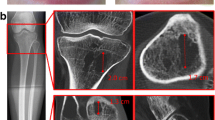Abstract
In a collaborative study from 7 European medical centres the radiographs of 24 patients with homocystinuria from 17 families were examined. The incidence and severity of bone manifestations were recorded. Homocystinuria may well be characterised as a spondylo-epimetaphyseal osteodysplasia because the main pathological changes occur in the vertebral column and in the epi-metaphyscal growth areas. Demineralisation was the leading symptom in the present series in all skeletal parts affected. In most instances careful examination of the radiographs enables the diagnosis of homocystinuria to be made radiologically. The pathogenesis and characteristic pattern of distribution of the osteoporosis require elucidation by further histological and biochemical investigation.
Similar content being viewed by others
References
Beckers, R. F.: Collective results of mass screening for inborn metabolic errors in eight European countries. Acta paediat. scand. (In press).
Brenton, D. P., Cusworth, D. C., Dent, C. E., Jones, E. E.: Homocystinuria: clinical and dietary studies Quart. J. Med.35, 325 (1966).
Brenton, D. P., Dow, C. J., James, J. I. P., Hay, R. L., Wynne-Davies, R.: Homocystinuria and Marfan's syndrome. J. Bone Jt. Surg.54 B, 277 (1972).
Carson, N. A. J., Dent, C. E., Field, C. M. B., Gaull, G. E.: Homocystinuria. J. Pediat.66, 565 (1965).
Carey, M. C., Donovan, D. E., FitzGerald, O., McAuley, F. D.: Homocystinuria. Am. J. Med.45, 7 (1968).
Dunn, H. G., Perry, T. L., Dolmann, C. L.: Homocystinuria. A recently discovered cause of mental defect and cerebrovascular thrombosis. Neurology16, 407 (1966).
Field, C. M. B., Carson, N. A. J., Cusworth, D. C., Dent, C. E., Neill, D. W.: Homocystinuria. A new disorder of metabolism. Abstr. Xth Internat. Congr. Pediat., Lisbon, 1962, p. 274.
Fisch, R. O., Graven, M., Feinberg, S. B.: Growth and bone characteristics of phenylcetonuries Ather. J. Dis. Child.112, 3 (1966).
Gaudier, B., Remy, J., Nuyts, J.-P., Caron-Poirrean Ch., Bombart, E., Foissac-Gegoux, M.-Ch.: Étude radiologique des signes osseux de l'homocystinurie. Arch. Franç. Péd.26, 963 (1969).
Gaull, G., Rassin, D., Sturmann, J.: Enzymatic and metabolic studies of homocystinuria: eflects of pyridoxine. Neuropediat.1, 199 (1969).
Gaull, G. E.: Homocystinuria, vitamin B6, and tolate: metabolic interrelationships and clinical significance. J. Pediat.81, 1014 (1972).
Gerritsen, T., Vaughn, J. G., Waisman, H. A.: The identification of homocystine in the urine. Biochem. Biophys. Res. Commun.9, 493 (1962).
Gfeller, J., Budliger, H.: Homocystinuria and os lunatum. Lancet1966 II, 548.
Holt, J. F., Allen, R. J.: Signes radiologiques des aminoaciduries primitives. Ann. Radiol.10, 317 (1967).
Morreels, C. L. Jr., Fletcher, B. D., Weilbaecher, R. G., Dorst, J. P.: The roentgenographic features of homocystinuria. Radiology90, 1150 (1968).
Mudd, S. H., Finkelstein, J. D., Irreverre, F., Laster, L.: Homocystinuria: an enzymatic defect. Science143: 1443 (1964).
Mudd, S. H., Edwards, W. A., Loeb, P. M., Brown, M. S., Laster, L.: Homocystinuria due to cystathionine synthase deficiency: the effect of pyridoxine. J. Clin. Invest.49, 1762 (1970).
Müller, K. M.: (in preparation).
Reynolds, J.: A re-evaluation of the “fish vertebra” sign in sickle cell hemoglobinopathy. Amer. J. Roentgenol.97, 693 (1966).
Schimke, R. N., McKusick, V. A., Huang, T., Pollack, A. D.: Homocystinuria: studies of 20 families with 38 affected members. J. Amer. med. Ass.193, 711 (1965).
Schmid, F., Kühnle, A.: Das Längenwachstum der langen Röhrenknochen im Bezug auf Körperlänge und Lebensalter. Fortschr. Röntgenstr.89, 350 (1958).
Smith, S. W.: Roentgen findings in homocystinuria. Am. J. Roentgenol.100, 147 (1967).
Tanner, J. M., Whitehouse, R. H., Healy, M. J. H. Standards for skeletal age. A new system for estimating the maturity of the hand and wrist with standards derived from 2600 healthy Boston children. Part. II. The scoring system. Int. Children's Centre, Paris 1962.
Author information
Authors and Affiliations
Rights and permissions
About this article
Cite this article
Schedewie, H., Willich, E., Gröbe, H. et al. Skeletal findings in homocystinuria: A collaborative study. Pediatr Radiol 1, 12–23 (1973). https://doi.org/10.1007/BF00972819
Issue Date:
DOI: https://doi.org/10.1007/BF00972819




